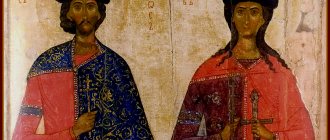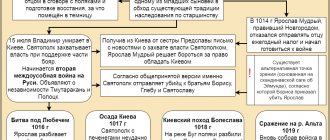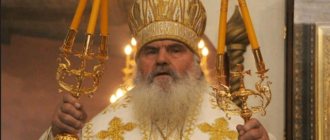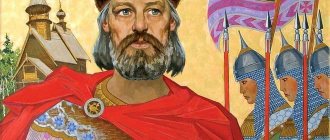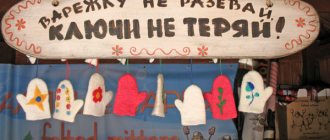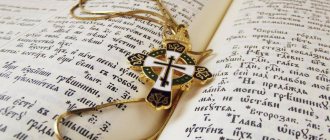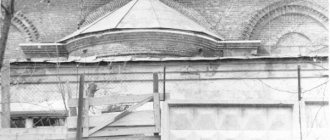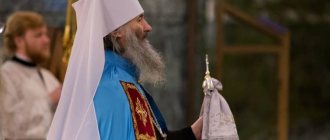| Saints Boris and Gleb. Icon of the 14th century. |
Boris and Gleb
, baptized Roman and David (+1015), holy noble-believing passion-bearing princes; the first Russian saints to be canonized. Commemorated on May 2 (transfer of relics in 1072 and 1115), July 24; September 5 - Gleb, in the Cathedrals: Rostov-Yaroslavl, Ryazan, Tula saints
The younger sons of the holy Equal-to-the-Apostles Prince of Kyiv Vladimir Svyatoslavich, who died in strife after his death at the hands of his elder brother Svyatopolk.
main sources
Information about Boris and Gleb, as well as about the development of their veneration, in addition to the chronicles (The Tale of Bygone Years, the Novgorod First Chronicle of the Younger Edition) was preserved in early hagiographic works dedicated to the saints - the anonymous “Tale, and Passion, and Praise of the Holy Martyr Boris and Gleb” (beginning .: “The generation of the righteous shall be blessed, the prophet spoke”) (hereinafter SS), in the closely related “Tale of miracles to the holy passion-bearer of Christ Roman and David” (beginning: “A man cannot speak and not be satisfied with the eye of seeing”) (hereinafter SS ) and in “Reading about the life and destruction of the blessed passion-bearer Boris and Gleb,” written by the hagiographer V. St. Nestor of Pechersk (beginning: “Sovereign Lord, Almighty, Creator of heaven and earth”) (hereinafter referred to as CHN), as well as in early liturgical monuments - the prologue life (beginning: “Martyr Boris grew up from his youth”) and 3 proverb readings ( beginning: “Brothers, help in troubles”; “Hearing Yaroslav, as his father died”, “To your walls, Vyshegorod”). Some details were also reflected in the ancient church chants of Boris and Gleb. The time of origin of the listed works, their sources and complex textual relationships are the subject of ongoing scientific discussions.
The most well-reasoned view at the moment is that the SS arose no later than 1072 (it does not mention the ceremonial transfer of the relics of Boris and Gleb that took place that year), but it is unlikely under Yaroslav the Wise (d. 1054), most likely in Kiev reign of Izyaslav Yaroslavich, in preparation for the celebrations of 1072, Izyaslav was named in baptism in honor of the Great Martyr. Demetrius of Thessaloniki - in the SS Boris and Gleb, as intercessors of the Russian land, are compared with Saint Demetrius of Thessalonica, and Vyshgorod, where the relics of the holy passion-bearers rested, are compared with the “second Selun” [1]. This helps to date the chronicle story. Firstly, it is indisputable that of the two editions in which it was preserved - in the PVL and in the NPL of the younger edition, the latter is closer to the SS, i.e. the edition contained in the previous PVL, the so-called. The initial arch of the 90s. V. Secondly, despite the fact that science has more than once expressed the opinion about the dependence of the chronicle story about the events of 1015–1019. from the much more extensive SS (Metropolitan Macarius (Bulgakov), E.E. Golubinsky, N.N. Ilyin, O. Kralik, A. Poppe), the opposite thesis seems more justified - that the SS was an extended hagiographic reworking of the chronicle story (A I. Sobolevsky, A. A. Shakhmatov, N. I. Serebryansky, S. A. Bugoslavsky, L. Muller, etc.). In the chronicle, in particular, borrowings from the Slavic translation of the Greek chronicle by George Amartol (or rather, “Chronograph according to the Great Exposition”) are more accurately conveyed. Thus, the original chronicle story about Boris and Gleb should be attributed to the Kiev-Pechersk chronicle of the 60s - early 70s. V. Apparently, the story reflected fairly early oral traditions, otherwise it would have been difficult to explain many of them. the details she provides, e.g. the names of the killers Boris (Putsha, Talets, Elovich, Lyashko) and Gleb (Goryaser, cook Torchin). At the same time, there is hardly any doubt that in Vyshgorod, with the beginning of miracles from the relics of the holy passion-bearers, already under Yaroslav the Wise, records began to be kept, which were reflected primarily in the SC and CHN. A hypothesis was also expressed about the existence of something allegedly created already in the 30s. V. hagiography about Boris and Gleb, perhaps in Greek (D.V. Ainalov, Muller).
SF in manuscripts (including in the oldest list as part of the Assumption Collection of the late 12th - early 13th centuries) usually forms a single complex with SS, although it is also found separately from the latter. In terms of prevalence, the SS is much inferior to the SS (according to G. Revelli, 43 lists versus 207), so in most cases the SS was rewritten separately from the SS. Therefore, contrary to this view. Sobolevsky, Shakhmatov, Serebryansky, N.N. Voronin, Muller, we are most likely talking about 2 independent works, united over time in some part of the manuscript tradition. The SCH in its final form took shape during the Kiev reign of Vladimir Vsevolodovich Monomakh (1113–1125), no earlier than 1115, for it contains a story about the transfer of the relics of Boris and Gleb that took place that year, as well as numerous praises addressed to Vladimir. For all that, the midrange is sometimes considered to be complex; Poppe dates its earlier part from the beginning of the Kyiv reign of Svyatoslav Yaroslavich (1073–1076), and S. A. Bugoslavsky - closer to the end. V. (after 1089). T. sp. S.A. Bugoslavsky, who identifies another, intermediate chronological layer in the SC, dating back to around 1108, seems unnecessarily complicated. According to Poppe, the initial part of the SN ended with the 6th miracle (“About the Blind Man”), but the view that the work of Svyatoslav’s time was shorter and ended with a message about the transfer of the relics in 1072, and the miracles from 4- go (“On chrome and dumb”) through 6 were added during the creation of the final edition under Vladimir Monomakh, when it is believed that the text of ChN was used (Muller, A. N. Uzhankov). However, it is possible and even more likely that both SCh and ChN had a common source - the mentioned Vyshgorod records about miracles at the relics of Boris and Gleb. Almost all researchers, following Shakhmatov, date ChN to the 80s. century, apparently closer to the beginning of the decade. Dating of S. A. Bugoslavsky, who considered ChN to be a work of the beginning. XII century, found no support.
Prayer text
Oh, sacred duo, beautiful brethren, good passion-bearers Boris and Gleb, who from their youth served Christ with faith, purity and love, and adorned themselves with their blood like scarlet, and now reigns with Christ! Do not forget us who exist on earth, but as warm intercessors, by your strong intercession before Christ God, preserve the young in holy faith and purity, unharmed from every excuse of unbelief and impurity, protect us all from all sorrow, bitterness and vain death, tame all enmity and malice, raised up by the action of the devil from neighbors and strangers. We pray to you, Christ-loving passion-bearers, ask the Great-Gift Master for forgiveness of our sins, unanimity and health, deliverance from the invasion of foreigners, internecine warfare, plagues and famine. Provide (this city) with your intercession to all who honor your holy memory, forever and ever. Amen.
The life and death of Boris and Gleb
| Icon of the passion-bearing princes Boris and Gleb. Second half of the 14th century. |
The named sources, as well as some foreign ones (primarily the German chronicle of the early centuries of Thietmar of Merseburg), describe the circumstances of the life and death of the younger Vladimirovichs as follows.
The SS and the chronicle story (textologically closely related to each other) call the mother of Boris and Gleb a certain “Bulgarian”, although on the basis of indirect data it has been repeatedly suggested that Boris and Gleb were the sons of Vladimir from a marriage with the Byzantine princess Anna (this hypothesis is most cogently developed by Poppe ). Judging by the names of the passion-bearing princes, information about their Bulgarian origin on the mother’s side deserves preference: the name “Boris” is of Bulgarian origin, the brothers Boris II and Roman occupied the Bulgarian throne respectively in 969–971 and 977–991, the name David is also known in ruling dynasty of the Western Bulgarian kingdom in the 2nd half. X century Perhaps the “Bulgarian” belonged to the Bulgarian royal family and came to Rus' as a captive in the 90s. X century, when Russian troops, as allies of Byzantium, took part in the war against the Bulgarians. It seems less likely that the children of the “Bulgarian” were born before the marriage of St. Vladimir with Anna, concluded in 988/89 (Müller), since this hypothesis contradicts the unanimous testimony of all sources that the saints died young. According to the SS and the chronicle, during his father’s life, Boris occupied the princely table in Rostov, and Gleb in Murom. The case is stated differently in the ChN. Here, the place of Boris' reign is apparently named Vladimir-Volynsky, where Boris settled after his marriage, and Gleb is presented as having been with his father in Kyiv during his childhood. It is difficult to make a decisive choice in favor of one version or another of the authors who worked approximately simultaneously (in the 70–80s). “Vladimer” in the phrase of St. Nestor’s “Tache ambassador and then father to the Vladimer region” [2] can be understood both as the name of the city and as a clarification of “father”. However, the 2nd interpretation does not fit well into the logic of the prp’s reasoning. Nestor, who sees precisely in Vladimir’s placing Boris on the table the root cause of the anger of Svyatopolk, who reigned in Turov, against his younger brother. Boris, who was sitting in distant Rostov, would not have posed any threat to the Turov prince, while Boris’s reign in Volyn could have led to a decrease in Svyatopolk’s inheritance (Volyn and Turov often represented a single ownership complex) and in any case threatened Svyatopolk’s connections with the Polish Prince Boleslav I, whose daughter Svyatopolk was married to. One way or another, Rev. Nestor, who wrote in the Kiev-Pechersk Monastery, could not help but be familiar with the original form of the chronicle story created there (his acquaintance with the SS is less likely), and, therefore, he had special reasons for avoiding the course of events outlined in it. CHN and SS differ in other details: according to the story of CHN, Gleb escapes from Svyatopolk by flight, while in the SS and the chronicle he, like Boris, voluntarily goes to meet his martyrdom. Obviously, in the middle - 2nd half. V. There were various legends about the circumstances of the life and death of Boris and Gleb, although attempts to detect traces of contamination of contradictory elements in the “Rostov-Murom” version itself (Shakhmatov) cannot be considered completely convincing.
Worthy of attention is the report of the ChN about Svyatopolk’s fears that Vladimir Svyatoslavich was supposedly going to leave Kiev not to the eldest of his sons (by that time Svyatopolk was one), but to Boris, which is why Vladimir, at the end of his life, took Boris out of his reign and kept him with him (the latter is confirmed also SS and chronicle). It seems that Vladimir was going to radically break the traditional order of succession, really seeing in Boris his successor, bypassing his older sons, perhaps as a result. the royal origin of the holy brothers, which explains the characteristic “royal” top in relation to Boris in the most ancient service (“the very rich Romane was adorned with the crown of the king”, etc.) and in Art. “About Boris, how would you rise”, included in the SS (Boris “young... still, shining like a crown prince”) [3]. However, this intention of the Kyiv prince was met in 1013–1014. to the active opposition of his eldest sons - Svyatopolk of Turov and Yaroslav, who was sitting in Novgorod, which gives grounds to attribute the publication of Vladimir’s plans regarding Boris to approximately 1012/13.
After the death of Prince. Vladimir (July 15, 1015), the Kiev table by right of seniority was occupied by Svyatopolk, although under not entirely clear circumstances (according to the most reliable data - the chronicle of Thietmar - Vladimir subjected Svyatopolk to imprisonment, in which he remained until the death of the Baptist of Rus').
These events found Boris returning at the head of his father's squad from a campaign against the Pechenegs. The warriors offered to support the prince in the fight for the Kiev table, but Boris refused, not wanting to “lay hands on his elder brother” [4]. After this, most of the squad left Boris (However, there are indications that Boris’s relations with the people of Kiev were not cloudless; for example, in the Tver collection of the 16th century, which preserved other details of the civil strife of 1015–1019 that were not in the PVL, we read , that when the boat with the body of the murdered Boris landed near Kiev, “they didn’t greet him, but kicked him away” [5]) Boris’s love of peace did not stop Svyatopolk, who sent several “Vyshgorod bolyars” (apparently, Vyshgorod was the place of Svyatopolk’s imprisonment) , to kill his younger brother. Warned of the approach of the killers, Boris “sang matins” in his tent, after prayer he lay down on his bed and was then stabbed to death. Along with Boris, many of his warriors were killed, including St. Georgy Ugrin, who covered the prince with his body, but some managed to escape (in particular, St. Moses Ugrin, brother of St. George; see also Art. Ephraim of Novotorzh, St.). Boris's body was taken to Vyshgorod (about 15 km north of Kyiv) and buried near the Church of St. Basil.
According to historical sources, Boris and his warriors were killed on Sunday, July 24. Both the SS and the chronicle name the place of their death as Boris’s camp on the Lte (Alta) River, near Pereyaslavl Russky. There is no complete confidence in the accuracy of the data about the place and day of Boris’s passion-bearing death. There is no date in the chronicle story; in addition, according to legend, reflected in the SS and the chronicle, the decisive battle between Yaroslav and Svyatopolk took place in 1019 on Lta and precisely at the site of the murder of Boris. This coincidence is aggravated by the fact that the battle took place “on the heel”, which fell on July 24 in 1019. The above gives reason to suspect that the topographical and chronological timing of the death of Boris to the place and time of the battle on Lita may have taken place later, during the formation of a hagiographical legend that emphasized the role of Yaroslav as an avenger for the blood of his brothers.
Summoned by deception from Murom, Gleb was killed on September 5 (and this date is not in the chronicle story) on the way to Kyiv near the mouth of the Smyadyn River, near Smolensk. According to ChN, Gleb was in Kyiv, fled to the north (to Yaroslav?) and was overtaken by killers near Smolensk. The body of the young prince was buried at the site of his death. After Boris and Gleb, another Vladimirovich was killed - Svyatoslav, who reigned in the Drevlyansky land (northwest of Kyiv). The denouement of this bloody drama was inevitably going to be a clash between Svyatopolk and his other brother, the Novgorod prince. Yaroslav. Their four-year struggle for the Kiev table, which proceeded with varying success, ended in the summer of 1019 with the aforementioned battle on Lita, in which Yaroslav won a final victory. Some time later (according to ChN, a year after Yaroslav’s installation in Kyiv, i.e. in 1017 or 1020), by order of Yaroslav, Gleb’s body was found and reburied next to Boris in Vyshgorod. The hypothesis that has recently gained a certain popularity that the killer of Boris and Gleb was Yaroslav [6] is based on Chap. arr. to scand. The saga of Eymund is a late source (late 13th century), confusing and more literary than historical, and cannot be considered seriously substantiated.
“Book” version of events a thousand years ago
After the death of Vladimir Svyatoslavovich in 1015, internecine strife resumed. According to the distribution, Svyatopolk went to Kyiv, Yaroslav - Novgorod, Boris - Rostov, Gleb - Murom. But Vladimir’s eldest son, Svyatopolk, sought to become the sole ruler of Rus' and for this he went to the murder of his brothers. He hired people who stabbed Boris to death on July 24, 1015 on the Alta River (flows in the Kyiv region - ed.). The prince was returning from a campaign against the Pechenegs. Svyatopolk summoned Gleb to Kyiv, supposedly to say goodbye to his father (in fact, by that time Vladimir had already been buried). On September 5, on the way to Kyiv, Gleb was stabbed to death near Smolensk, on the Smyadina River. Yaroslav, having learned about the murder of his brothers, and probably fearing for his own life, marched with an army against Svyatopolk and defeated him.
Canonization of Boris and Gleb
The events associated with the emergence of the veneration of Boris and Gleb are known thanks to SCh and ChN, which in this part apparently go back to a common source - the Vyshgorod records. For some time, the grave of Boris and Gleb near the Vyshgorod Church of St. Vasily was in oblivion or neglect, judging by the fact that the first sign from the relics of the saints happened when a certain “Varangian”, who accidentally stepped on the grave, had his feet singed by flames coming from under the ground. “And from then on I did not dare to approach the cup, but bowed down with fear” [7]. Soon the Church of St. Vasily burned down, but all the icons and liturgical utensils were saved, which was understood as the intercession of the holy passion-bearers. The incident was reported to the Kyiv prince. Yaroslav the Wise and Metropolitan. John I, who, accompanied by “the choir and the entire priesthood,” went to Vyshgorod and, in the presence of the prince, performed an all-night vigil in the chapel (“kletse male”), built over the grave of Boris and Gleb. After a new one was built on the site of the burnt church, the bodies of the saints, by order and with the participation of the Metropolitan, were solemnly “worn from the ground.” At the same time, the crayfish were opened, and the incorruptibility of the relics and the fragrance emanating from them were attested, then they were installed in the new church “above the earth in the gums of the country.” Miraculous healings began to occur from the holy relics, the sequence of which in the SS and CN is almost the same.
Miracles 1st (“O lame” - the healing of the youth of the Vyshgorod mayor Mironeg) and 2nd (“About the blind man”) served for the book. Yaroslav's foundation should be built on the advice of Metropolitan. John in Vyshgorod, a large five-domed wooden church in the name of Boris and Gleb, consecrated on July 24, where the relics of St. princes. On this day, which coincided with the murder of Boris, an annual holiday for the saints was established. At the first liturgy in the new church, in front of the prince and metropolitan, the 3rd miracle (“O Chromem”) occurred. In this regard, the ChN reports that Yaroslav established tithes from princely tributes from Vyshgorod to support the clergy of the newly built church. Further, in both the SC and the CHN (which also contains a story about the miracle of deliverance from the shackles of prisoners “in a certain city”), the message about the death of Yaroslav the Wise is followed by a story about the transfer of the relics of Boris and Gleb in 1072 to a one-domed church built by the Kyiv book Izyaslav Yaroslavich due to the dilapidation of the Yaroslav temple. This transfer, the most complete description of which is preserved in the SCH, was much more solemn than the previous one: the princes (Izyaslav, Svyatoslav, Vsevolod Yaroslavich with their sons) and Metropolitan George with his clergy, a number of other bishops (Neophyte of Chernigov, Peter of Pereyaslav, Nikita of Belgorod) took part in it , Mikhail Yuryevsky), as well as the abbots of Kyiv monasteries, among whom was St. Theodosius Pechersky. The transfer of the relics took place on May 20, the 7th week of Easter, when another day of commemoration of Boris and Gleb was established (the indication of May 2 in the Laurentian Chronicle and related vaults is apparently explained by contamination with the date of transfer of the relics in 1115).
Then there are stories about new miraculous healings: “About the lame and dumb” (4th miracle), “About the wife of Sukharuts” (5th) and “About the blindness” with the participation of the great martyr. George (6th), and in the latter in the mouth of St. George describes Boris and Gleb as saints, to whom “grace was given from God in this country, the land of Russia, to sling and heal every passion and illness” [8]. This is where the ChN ends with praise to the saints, and the SN continues to describe the events associated with the veneration of Boris and Gleb up to 1115 inclusive: the unsuccessful attempt to erect a stone church in honor of St. passion-bearers (started under Svyatoslav and completed under Vsevolod, it collapsed immediately after the completion of the work), the failed similar plan of the Kyiv prince. Svyatopolk Izyaslavich (1093–1113), forging the wooden shrine of Boris with gilded silver through the acquisition of Vladimir Monomakh (then Prince of Pereyaslavl) in 1102/3, restoring a collapsed stone temple at the expense of the Chernigov prince. Oleg Svyatoslavich in 1112 and, finally, after the death of Svyatopolk, the solemn transfer of the relics of the passion-bearers to the new stone church on Antipascha, 1115, May 2.
The transfer of the relics to the large five-domed church under Yaroslav is described as the church glorification of the new martyrs (the message about the painting of the icon of Boris and Gleb is only in the ChN), therefore its more or less accurate dating would be important, which, however, turns out to be extremely difficult. Shakhmatov's assumption, supported by some researchers, that the transfer took place in 1020 or 1026, is based solely on the assumption that the ceremony must necessarily have occurred on a Sunday, as was the case in 1072 and 1115. But the same condition is satisfied in 1037, 1043, and 1048. And it is unlikely that Yaroslav, having decided to build a church in honor of Boris and Gleb, would have waited for a year, when July 24 would have coincided with Sunday. The time of the sainthood of Metropolitan. John I, who for some reason is considered in science to be the predecessor of Metropolitan mentioned in the chronicle in 1039. Theopempta, nothing prevents us from attributing it to the 40s. c., therefore it is not at all necessary to date the construction of the Yaroslav Church to the 30s. this century (Müller). The statement of the SCH that the transfer of the relics of Boris and Gleb to the church built by Izyaslav Yaroslavich in 1072 took place “last (after what? - A.V. Nazarenko, Orthodox Encyclopedia) in the summer of 20” [9], can hardly be correlated with the moment of construction Yaroslav Church, because in this case it would have occurred at the precisely attested time of Metropolitan. Hilarion (1051 - no later than 1054), and not John. Obviously, this indication refers to the death of Yaroslav, which is more justified by the context of the narrative. If, in addition to what has been said, we take into account the silence about Boris and Gleb in “Praise to Prince. Vladimir" Met. Hilarion, the dating of which ranges from 1037 to 1050, then the most likely time for the transfer of the relics under Yaroslav and the establishment of the holiday of Boris and Gleb on July 24 will have to be recognized as the 2nd half. 40s V.
This dating is confirmed in the princely name book. The earliest of the numerous naming of princes after the names of new saints in the families of both the Yaroslavichs (Gleb, David, Roman Svyatoslavich, David Igorevich, Boris Vyacheslavich) and the Polotsk prince. Vseslav Bryachislavich (Gleb, David, Boris, Roman) definitely date back to the life of Yaroslav the Wise (Gleb Svyatoslavich was born no later than 1050/51, Gleb and David, since they were the eldest sons of Vseslav of Polotsk, no later than 1053/54), whereas those born in 1036 and several times. Previously, the two youngest sons of Yaroslav himself were named Vyacheslav and Igor, which does not fit well with the assumption of the canonization of Boris and Gleb under Metropolitan. John, if the latter was the predecessor of Theopemptos. At the same time, it should be taken into account that the surviving seals of David Igorevich, who was born in the 50s. XI century, bear the image not of Gleb - David, but of the prophet. David [10]. This suggests that these namings took place even before the names of Boris-Roman and Gleb-David were included in the calendar, although they were a consequence of the veneration of the martyred princes within the princely family. In this case, the establishment of the holiday on July 24 under Yaroslav should be regarded as a local canonization within the Kyiv diocese (which included Vyshgorod), and all-Russian. the glorification is attributed to 1072. The dating of the all-Russian canonization of 1088 [11] looks unjustifiably late and is based on a very controversial premise that the ChN was the first hagiographic work about Boris and Gleb, while the SS supposedly could not have been such (S. A. Bugoslavsky); The mention of Boris and Gleb in the list of saints in birch bark document No. 906, which stratigraphically falls on the 3rd quarter, also speaks against it. XI century [12].
Why is Svyatopolk considered a murderer?
For a long time, the residents of Vyshgorod did not know who was buried near the Church of St. Vasily. The grave was so inconspicuous that people even walked on it. They also did not know the circumstances of Boris’s death. After transporting Gleb’s body, when they started talking about an alleged miracle over the graves of the brothers, the townspeople were clearly aware of the fact - princely civil strife. The princes were canonized in 1072. Then the source of the story about their murder was born.
Why was this necessary?
At the turn of the 60-70s. XI century Internecine struggle intensifies. Events were reminiscent of 1018. The exiled Kiev prince Izyaslav calls on his relative, the Polish prince Boleslav, for help. In 1073 they were defeated by the combined forces of other brothers - Vsevolod and Svyatoslav. Izyaslav is sent into exile. In the absence of clear information, the negative image of Izyaslav was transferred to a similar position of Svyatopolk.
Having strengthened themselves in the international arena as rulers of an independent and powerful state entity, the Kiev elite desired such status for the clergy. The rise of ethnic and social self-awareness was felt, and ideological independence from Byzantium was desired. One of the signs of spiritual self-sufficiency is the presence of your own saints. And one of the main grounds for canonization was supposed to be martyrdom. What was needed was the image of a killer - a monster capable of exterminating his family. The choice fell on Svyatopolk, whom society had forgotten and who, unlike Yaroslav, did not have descendants capable of protecting his memory.
